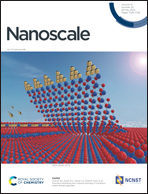Correlation of the crystal structure and ion storage behavior of MoO3 electrode materials for aluminum-ion energy storage studied using in situ X-ray spectroscopy†
Abstract
To characterize the correlation of the crystal structure and Al-ion storage behavior, we prepared various crystal structures of MoO3 (α-MoO3, β-MoO3 and h-MoO3) electrode materials and studied them via in situ X-ray absorption spectroscopy (XAS) and X-ray diffraction (XRD) techniques. The α-MoO3 electrode material possesses a specific capacitance of 575.4 F g−1 and a gravimetric capacity of 207.8 mA h g−1 at a current density of 1 A g−1. From the in situ XRD results, the crystal structures of α-MoO3 and β-MoO3 show a significant distortion, whereas that of h-MoO3 is minorly affected during the insertion or extraction of Al3+ ions. Based on the in situ XAS results, the MoO6 octahedral structure and Mo ion valence of α-MoO3 and β-MoO3 also exhibit a strong variation, whereas those of h-MoO3 are nearly unchanged during the insertion or extraction of Al3+ ions. Notably, in situ XRD and XAS also clearly show a possible phase of AlxMoO3 during the Al3+ insertion and extraction cycles in the α-MoO3 and β-MoO3 electrode materials, which may play a crucial role in the behavior of the residue of Al3+ ions and poor cycling stability. We provide clear evidence that the Al-ion energy storage performance of various MoO3 electrode materials is strongly associated with the corresponding tunnel space and the stability of their crystal structures. This work also provides new insight into a strong correlation between ion-storage efficiency and the corresponding crystal structure, which is greatly helpful for the development and improvement of new electrode materials for Al-ion energy storage.



 Please wait while we load your content...
Please wait while we load your content...